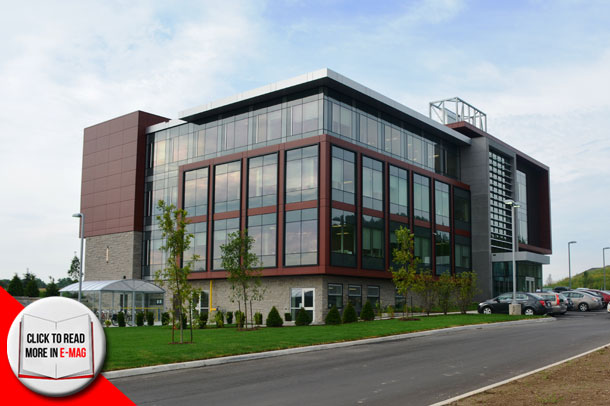Promoting and protecting the health of our community
~ By Leah Kellar
The counties of Wellington and Dufferin and the city of Guelph are benefiting from two new Public Health facilities located in Orangeville and Guelph—a $25-million project funded by the municipalities. Public health agencies are mandated by the province to promote healthy communities and support healthy lifestyles while preventing disease and injury. There are 26 public health units across Ontario. Wellington-Dufferin-Guelph (WDG) Public Health serves the counties of Dufferin and Wellington and the City of Guelph and is located just west of the Greater Toronto Area in the south central part of Ontario.
“Public Health is often the invisible healthcare organization,” said WDG Public Health’s Medical Officer of Health and CEO, Dr. Nicola Mercer in a recent interview with Business Elite Canada.
What Dr. Mercer means is that when people think generally of healthcare they often think of hospitals, doctor’s offices or clinics. But Public Health is busy promoting health and preventing disease so people don’t have to go to the hospital or see their doctor so often.
“We are the inspectors, your nurses, your dieticians, your health promoters, the people that are there in the community making sure the restaurants, pools or beaches are safe for you and your family. Public Health also investigates the outbreak of infectious diseases, provide immunizations and information on staying healthy and raising healthy children,” she said. For anyone who does not know what Public Health does—WDG Public Health’s website: www.wdgpublichealth.ca describes themselves as a community within a community that promotes and protects the health of residents providing vital healthcare information and services through a variety of programs and initiatives.
Public Health proves its practical value in the delivery of programs at the community level, including those that promote healthy infant and child development, responsive parenting, reproductive, sexual and dental health; disease and injury prevention. They also protect communities from communicable and infectious diseases and environmental hazards such as contaminated food and water—and much more.
WDG Public Health is governed by an autonomous Board of Health. Dr. Mercer, who holds a dual position as both Medical Officer of Health and CEO, sits with a senior management team of four to oversee services and provide direction to more than 200 full- and part-time staff members. There are six Public Health office locations throughout Wellington and Dufferin counties and in the city of Guelph.
Carrying the responsibility as Medical Officer of Health and also CEO of Wellington-Dufferin-Guelph Public Health has its advantages. Namely being able to see both sides of a healthcare issue in terms of program delivery using her medical background and managing resources using her knowledge of business management.
But Dr. Mercer did not get into the role through the traditional route. She holds a Master of Business Administration from Wilfrid Laurier University and a Master of Public Health from University of Waterloo. As a practicing physician she has had hospital privileges at five hospitals including the Guelph General Hospital for 15 years, practicing Intensive Care Medicine and Anesthesiology. She has been the Chief of the Department of Anaesthesiology, an Examiner for the Royal College of Physicians and Surgeons of Canada and involved in the Ontario Medical Association. She is currently the president of the Wellington County Medical Association.
“I think having the medical and the business management skill sets really provides a beneficial set of strengths,” said Dr. Mercer.
Seeing the development of the new Public Health offices in Guelph and Orangeville is certainly a high point in Dr. Mercer’s seven years with WDG Public Health. And the two new facilities are already benefiting local healthcare in numerous ways. Public Health unfortunately has never had adequate teaching or meeting spaces. It often had to rely on other like-minded agencies for these spaces. It now has teaching kitchens, modern clinics and adequate teaching spaces that can handle the diverse work of Public Health as it serves local communities for generations to come.
“Services can all be delivered on site now. That was always very difficult in the past, so that’s a great feature,” said Mercer.” “Public Health provides important services for some who would otherwise have no place to turn. Our dental services focus on low-income children in need of dental treatment. These are children who come from families who qualify for assistance with dental and payments service because of economic hardship and lack of insurance.”
In terms of immunization services WDG now has the space to do mass immunizations if there is ever the need. “The buildings have the capacity to respond to public health emergencies in a way that none of our other facilities could,” said Dr. Mercer. “Let’s hope that won’t be necessary, but you always have to plan ahead with emergency preparedness in case, say10,000 people need to be immunized very quickly.”
Another advantage of the new facilities is that staff and clients are now in a healthier environment. The buildings were designed with access to natural light and infection control measures are featured throughout the building. Clinical, dental and teaching classrooms were all designed so staff can effectively deliver services. Both buildings are centrally located for greater accessibility by public transit, bike or foot: one is in downtown Orangeville and the Guelph site is on the University of Guelph campus and near busy shopping facilities.
Funding for the buildings came from a municipal financial agreement between the County of Wellington, the County of Dufferin, and the City of Guelph. That agreement encompasses a 20-year financial agreement between WDG Public Health and the municipalities with the Board of Health authorizing Public Health to borrow up to $25,000,000. One-time grants from the province of Ontario helped reduce the amount to be borrowed from the municipalities to $22,000,000.
“Our municipalities make up the majority of the Board of Health and they’re also our funder for this project and so without their support and commitment to public health services in the community, this project would not have been initiated,” said Dr. Mercer.
The need for this funding and two brand new facilities came from a number of factors that plagued WDG Public Health over the years. The facility in Orangeville did not meet accessibility guidelines and could not house all Public Health programs. In Guelph, an outdated facility prompted the move to several temporary locations creating accessibility and service delivery problems for the past seven years.
A host of technological and equipment upgrades accompanied the development of the new facilities such as internal water source heat pumps, heat recovery, efficient plumbing systems and energy efficient LED and T5 lighting.
A few other equipment upgrades specific to Public Health were added such as generators for vaccine fridges in case of a power failure. All of the government funded vaccines are available through Public Health. Consequently, at any one time, especially at the start of flu season, Public Health could have up to $18-million worth of vaccine in the fridges. WDG Public Health also has an emergency operations centre to respond to local emergencies, a short-wave radio communication’s room and an antenna for emergency communication in the event of a significant power outage. Another unique addition is a designated clinic area with an air ventilation system for seeing people with airborne disease like tuberculosis or measles.
“I think the first challenge you have with any kind of construction project is solidifying your dream into what you really need and can afford. When we overcame that hurdle, these new facilities became a reality and will identify a place and a face for Public Health within these particular communities,” said Dr. Mercer. “Now there’s actually a new physical place where people can say, ‘Oh, that’s the Public Health building, I know where it is, and I know where to get great accessible healthcare information and services.”







